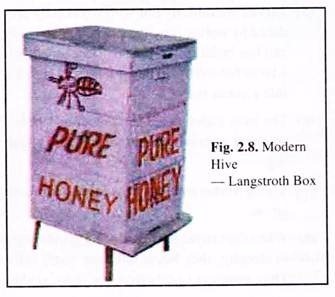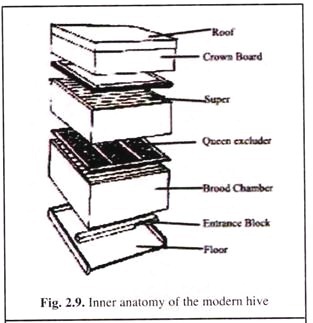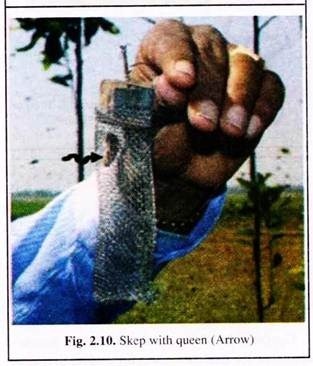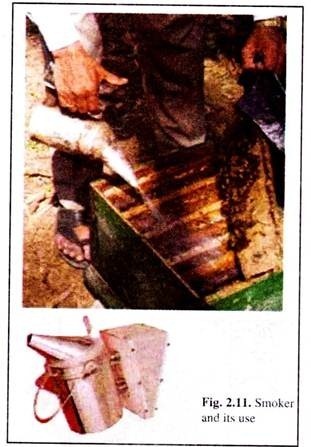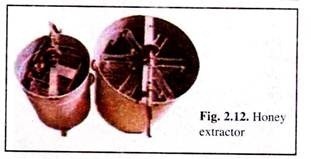Culture Practice # 1.
Genetic Manipulation of Bees:
All the sub-species of Apis mellifera are capable of inter-breeding and hybridizing. Many bee breeding companies strive for selective breed and hybridised varieties to produce desirable qualities: disease and parasite resistance, good honey production, swarming behaviour reduction, prolific breeding, and mild disposition.
Some of these hybrids are marketed under specific brand names, such as the Buckfast Bee or Midnite Bee. The advantages of the initial F1 hybrids produced by these crosses include hybrid vigour, increased honey productivity, and greater disease resistance. The disadvantage is that in subsequent generations these advantages may fade away and hybrids tend to be very defensive and aggressive.
Culture Practice # 2.
Indigenous Methods of Bee-keeping:
ADVERTISEMENTS:
Many villagers make wall or fixed types of hives in rectangular spaces in the walls with a small hole or movable types of hives in wooden boxes or earthen pitchers. The traditional bee-keepers catch clustered swarms from trees, bushes, etc. and transfer them to the above mentioned spaces.
After sometime when the honey is ready, the bees are driven away from the comb usually by smoking the hive. Then the comb is cut away and the honey is squeezed out through a piece of large meshed cloth.
Culture Practice # 3.
Modern Hives – Langstroth Box:
In modern bee-keeping, the combs are built on wooden frames that are moveable. This facilitates inspection and management of bee colonies. Three types of moveable frame hive are in common use: the Newton type along with its standardized version ISI Type A, the Jeolikote Villager and its counterpart ISI Type B, and the Langstroth type (Fig. 2.8).
ADVERTISEMENTS:
The beehive is made up of a series of square or oblong boxes without tops or bottoms, set one above the other.
This hive has the floor at the bottom with a crown board at the top and a roof over all. Inside these boxes, wooden frames are vertically hung, parallel to each other. The wooden frames are filled with sheets of wax foundation on which the combs are built by the bees.
The only entrance to the hive is below the large bottom box (brood chamber). The queen is usually confined to the brood chamber. The boxes termed supers are used for storage of honey. The queen is prevented from going to the supers by the queen-excluder that allows only the workers to move.
Culture Practice # 4.
Catching a Swarm and Queen:
ADVERTISEMENTS:
Swarms, i.e., an old queen accompanied by huge population of workers, are collected from where they are settled. Special kind of container is needed to collect the queen, called skep. The container is usually a straw or a wire-net basket with a lid (Fig. 2.10).
Culture Practice # 5.
Hiving a Swarm:
It is the process in which the collected swarm is transferred to the hive to build up the colony and produce honey.
It is operated in two ways:
(i) Traditional Method:
The hive is set up with brood chamber filled with its full number of frames. Each frame has a full sheet of foundation and there is a crown board with roof at the top. A sloping board with white sheet is set against the entrance of the hive. Bees in the skep (basket) are knocked out of it onto the slope. The instinct of the bees to move upwards onto the dark, drives them onto the hive through the entrance.
ADVERTISEMENTS:
(ii) Quick Method:
In this method the crown board of the hive is taken off. Frames are also taken off and the entrance is closed. The skep is intimately united with the hive and the bees are poured into the brood chamber from the top. The frames containing the wax foundation are placed in the hive.
The crown board is put back in its position and the entrance is opened. It must be seen that the queen enters the hive. Sugar syrup is then fed to the swarm, as this feeding will help the bees to settle down to work in their new home.
Culture Practice # 6.
Bee Pasturage:
The plants that yield nectar and pollen are collectively termed “bee pasturage”. The fruit trees, ornamental plants and forest trees comprise important bee pasturage. Nectar is the sweet secretion of the flowers. It is raw material for honey. Pollen provides the raw material necessary for the major food of the brood.
Culture Practice # 7.
Extraction of Honey:
Successful commercial extraction of honey from the hive requires some instruments.
These are described below:
(i) Smoker:
Smoker (Fig. 2.11) is a stainless steel flask with heat guard and a tube at the top for ejecting smoke. At the side of the flask there is a blower for blowing the smoke from inside to the hive. Various smoking agents are used in different parts of the country.
During the time of honey extraction smoke is produced and sprayed on the hive to remove the workers from the hive. Then frames are taken out and put into the honey extractor.
(ii) Honey Extractor:
Honey extractor (Fig. 2.12) is a hand-operated roller drum with arrangement for holding frames in it. After keeping frames, the roller is rolled manually in a reasonable speed to extract honey, i.e., centrifugal force is applied on frames. Honey is collected in the drum until all the chambers become empty. At the end the honey is collected from a channel situated at the bottom of the chamber.
